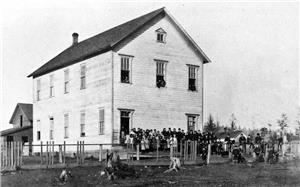In January 1882, the Seattle School Board holds a public meeting to lament deplorable and inadequate school facilities and to gain public support for funding new buildings. One teacher, speaking of crowded conditions in the South School (built in 1872 at S 12th Avenue and Lane Street) informs the board that if the classroom became more crowded she would find more space by "hanging the little fellows up on the hooks on the walls of the room" (Erigero).
Shanties for Schools
The Seattle Public schools consisted at this time of the Central School, a two story frame building in on 3rd Avenue between Madison and Spring streets, and two small satellites, the above mentioned South School, and North School, at the corner of 3rd Avenue and Pine Street.
All were termed "shanties" at the meeting, and compared with "beautiful and imposing edifices in San Jose, California, which make that little city famous all over the coast." In fact, the public minded citizens in attendance deemed Seattle's shanties-for-schools worse than the jail.
"For God's Sake!" thundered the chairman of the board, J. R. Lewis. "Let us have a school boom!" (Erigero).
Dingy...
The meeting was followed by school visitations by a delegation consisting of a Seattle Post-Intelligencer reporter, the school board members, and the school clerk. The reporter wrote of the Central School:
"The [second floor] room is a dingy, ill-ventilated apartment with from 85 to 90 children crowded together on low uncomfortable benches, three to a seat. ... Way up in the garret ... each pupil, when his or her turn has come to read, is sent over to stand by the window in order to get sufficient light to read" (Erigero).
Seattle had its school boom. The school district was voted the funds to erect two new school buildings.

